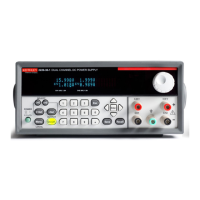Command Syntax
Abbreviating Commands,
Queries, and Parameters
You can abbrevi
ate most SCPI commands, queries, and parameters to an accepted
short form. This manual shows these commands as a combination of upper and
lower case letters. The upper case letters indicate the accepted short form of a
command, as shown in the following figure. The accepted short form and the long
form are equivalent and request the same action of the instrument.
Figure 2-3: Example of abbreviating a command
Chaining Commands and
Queries
You can chain several commands or queries together into a single message. To
create a chained message, first create a command or q
uery, then add a semicolon
(;), and finally add more commands or queries and semicolons until you are done.
If the command following a semicolon is a root node, precede it with a colon
(:). The following figure illustrates a chained message consisting of several
commands and queries. The chained message should end in a command or query,
not a semicolon. Responses to any queries in your message are separated by
semicolons.
Figure 2-4: Example of chaining commands and queries
If a command or query has the same root and lower-level nodes as the previous
command or query, you can omit these nodes. In the following figure, the second
command has the same root node (STAT:QUES) as the first command, so these
nodes can be omitted.
Figure 2-5: Example of omitting root and lower level nodes
Series 2200 Programmable Multichannel DC Power Supplies Programmer Manual 2-5

